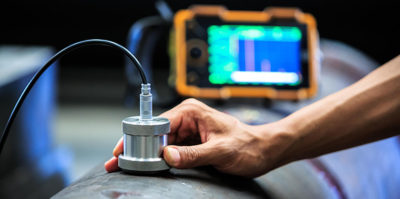There are a variety of methods that can be used to establish a magnetic field in a component for evaluation using magnetic particle inspection. It is common to classify the magnetizing methods as either direct or indirect.Magnetization Using Direct Induction (Direct Magnetization)With direct magnetization, current is passed directly through the component. Recall that whenever current flows, a magnetic field is produced. Using the right-hand rule, which was introduced earlier, it is known that the magnetic lines of flux form normal to the direction of the current and form a circular field in and around the conductor. When using the direct magnetization method, care must be taken to ensure that good electrical contact is established and maintained between the test equipment and the test component. Improper contact can result in arcing that may damage the component. It is also possible to overheat components in areas of high resistance such as the contact points and in areas of small cross-sectional area.  There are several ways that direct magnetization is commonly accomplished. One way involves clamping the component between two electrical contacts in a special piece of equipment. Current is passed through the component and a circular magnetic field is established in and around the component. When the magnetizing current is stopped, a residual magnetic field will remain within the component. The strength of the induced magnetic field is proportional to the amount of current passed through the component. There are several ways that direct magnetization is commonly accomplished. One way involves clamping the component between two electrical contacts in a special piece of equipment. Current is passed through the component and a circular magnetic field is established in and around the component. When the magnetizing current is stopped, a residual magnetic field will remain within the component. The strength of the induced magnetic field is proportional to the amount of current passed through the component. A second technique involves using clamps or prods, which are attached or placed in contact with the component. Electrical current flows through the component from contact to contact. The current sets up a circular magnetic field around the path of the current. Magnetization Using Indirect Induction (Indirect Magnetization)Indirect magnetization is accomplished by using a strong external magnetic field to establish a magnetic field within the component. As with direct magnetization, there are several ways that indirect magnetization can be accomplished.The use of permanent magnets is a low cost method of establishing a magnetic field. However, their use is limited due to lack of control of the field strength and the difficulty of placing and removing strong permanent magnets from the component.Electromagnets in the form of an adjustable horseshoe magnet (called a yoke) eliminate the problems associated with permanent magnets and are used extensively in industry. Electromagnets only exhibit a magnetic flux when electric current is flowing around the soft iron core. When the magnet is placed on the component, a magnetic field is established between the north and south poles of the magnet. A second technique involves using clamps or prods, which are attached or placed in contact with the component. Electrical current flows through the component from contact to contact. The current sets up a circular magnetic field around the path of the current. Magnetization Using Indirect Induction (Indirect Magnetization)Indirect magnetization is accomplished by using a strong external magnetic field to establish a magnetic field within the component. As with direct magnetization, there are several ways that indirect magnetization can be accomplished.The use of permanent magnets is a low cost method of establishing a magnetic field. However, their use is limited due to lack of control of the field strength and the difficulty of placing and removing strong permanent magnets from the component.Electromagnets in the form of an adjustable horseshoe magnet (called a yoke) eliminate the problems associated with permanent magnets and are used extensively in industry. Electromagnets only exhibit a magnetic flux when electric current is flowing around the soft iron core. When the magnet is placed on the component, a magnetic field is established between the north and south poles of the magnet. Another way of indirectly inducting a magnetic field in a material is by using the magnetic field of a current carrying conductor. A circular magnetic field can be established in cylindrical components by using a central conductor. Typically, one or more cylindrical components are hung from a solid copper bar running through the inside diameter. Current is passed through the copper bar and the resulting circular magnetic field establishes a magnetic field within the test components.The use of coils and solenoids is a third method of indirect magnetization. When the length of a component is several times larger than its diameter, a longitudinal magnetic field can be established in the component. The component is placed longitudinally in the concentrated magnetic field that fills the center of a coil or solenoid. This magnetization technique is often referred to as a “coil shot.”  | |
